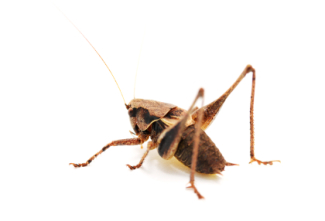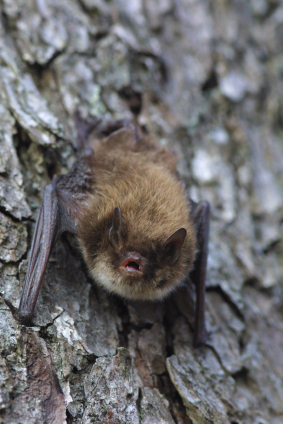Spelunking for a Degree, Part 3: Incomplete Food Chains & Crickets
 August 24, 2010
August 24, 2010 
The beetles I traveled to the Kentucky caves to collect are part of a cave ecosystem of insects, small mammals such as rats, and various types of fungus.
Cave ecosystems contain incomplete food chains. The start of most food chains consists of producers, usually green plants or algae. They make food by photosynthesis, using light energy from the sun. Then other organisms feed on the producers.
But no light enters caves, so no producer can start a food chain there. The cave ecosystem requires some creatures to leave, eat vegetation outside the cave, then return with the food, or their own waste from the food. In the Mammoth-Flint Cave System, animals that go out to feed and return to start food chains are rats and crickets.
I was surprised when I first shined my helmet light on the crickets. They’re about twice the size of ordinary black crickets. And these cave crickets are pink. They don’t need protective coloring, because the cave is pitch black, and they leave the cave to feed only at night. So they have evolved to be colorless, saving the energy it would take to manufacture pigment. Their pink color is just the natural color of the protein that makes up their exoskeletons.
Neither the crickets nor the cave beetles I was researching started out in the caves. Hundreds and thousands of years ago, the ancestors of these insects lived in the woods. Gradually, some groups of crickets and beetles began feeding exclusively underneath the leaf litter that covers the forest floors. It was dark under the leaf litter, so the more immediate ancestors of cave crickets and cave beetles adapted to life in the dark even before any of them ventured into caves.
Wind, rain, and animals moved leaf litter into the mouths of caves, and the beetles and crickets moved along with the litter. Gradually, they moved further into the caves. This favored the crickets, because they could nest in a more protected area with few predators. It favored the beetles, because they could find a steady food source of cricket guano with less competition from other feeders. Other animals, as well as various species of fungus may have entered the caves at the same time or before or after. And so a cave ecosystem was born.
The caves were a refuge during ice ages when glaciers covered what is now Kentucky. Life in the cave turned out to be pretty safe as long as a few hearty creatures could venture out to forage under the snow and ice.
Isn’t it awesome the way every cranny of the earth gets populated? Adaptation has made even cold, pitch dark caves hospitable for species like bats, cave crickets, and cave beetles.
 beetle,
beetle,  cave,
cave,  cricket,
cricket,  ecosystem,
ecosystem,  food chain
food chain 

